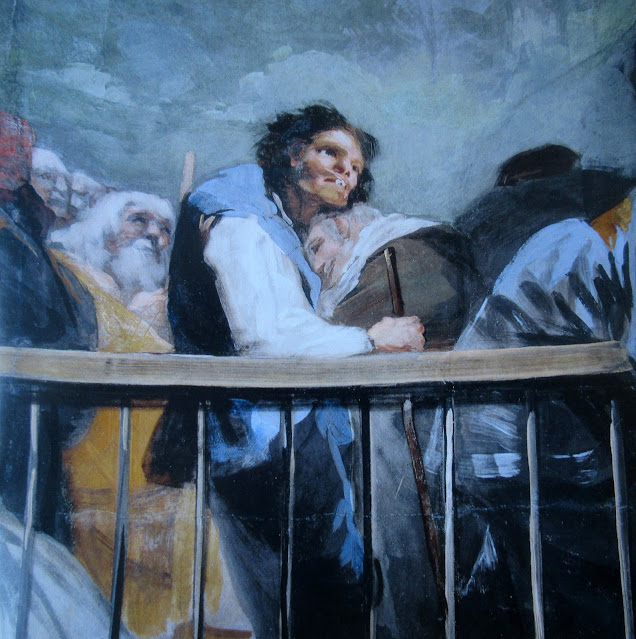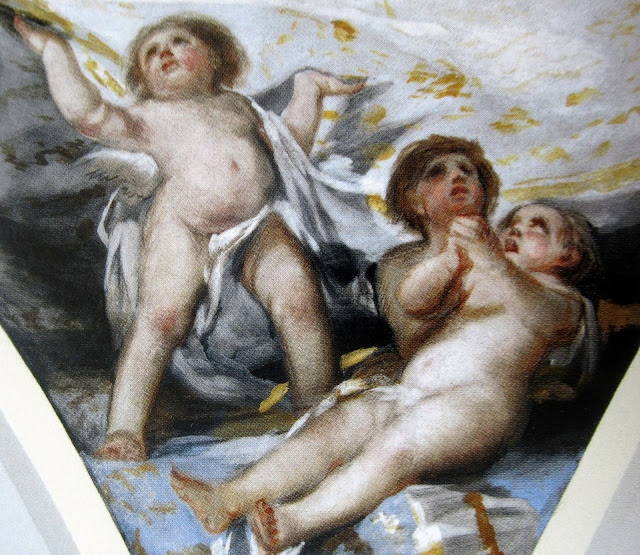The church of San Antonio de la Florida has frescoed ceilings painted by Goya in 1798 - it's one of the few places one can see Goya masterworks in their original setting.
There are two identical chapels on the left bank of the Manzanares, facing the Casa de Campo which really confused us at first. Built originally as a small royal chapel, San Antonio de la Florida, was made a parish church in 1881. Over time candle smoke and incense began to damage the frescoes so in 1905 the building was established as a National Monument. A second twin church was built to serve the parish and the original chapel was kept only as a museum.
Taking photographs inside the church was not allowed but I managed to surreptitiously take a few - well, not that surreptitiously as I was told off three times by three different people. They all calmed down however when I bought the book on the chapel. So, some of the photographs in this post are the ones I took and some I copied from the book.
The church is small but well-proportioned. It has a single nave with some smaller outbuildings, a central dome and cupola.
The altar is crowned with two classical angel figures, bowing before the Holy Trinity symbol which is carved with golden rays. In the large niche an 18th-century ivory, stone and gilt-bronze Christ on the cross is sheltered.
Francisco de Goya is buried before the altar. Over the granite tomb there is a marble inscription, which was brought from his original tomb in Bordeaux.There the painter had been laid to rest in the family vault of Martin Mighel de Boicoechea, whose daughter had married Goya's only son, Javier. Since Goya and Coicoechea were buried together in Bordeaux, both of their remains were brought to San Antonio in 1919, to avoid possible identification problems. Also, the painter's skull is missing; it was stolen in the last century, perhaps by some excessiveoy keen phrenologist.
The chapel's frescoes were painted by Francisco de Goya y Lucientes, the foremost painter of his time and one of the undisputed masters of Werstern art. Goya broke free from academy rules and in his later years developed new forms of expression, which have helped shape contemporary artistic thought and styles. Some of these techniques are evident in the frescoes in the chapel. Goya was fifty-two when he began working on this chapel, and at the peak of his creative power.
The main scene in the dome is built around an incident in St Athony's life. St Anthony, a Franciscan friar, lived in the 13th century in the city of Padova. One day, he got news that his father was wrongfully accused of murder. Miraculously, he travelled to Lisbon where the trial was being held, and demanding to see the slain victim, asked him whether the accused was guilty of his death. As a crowd of people watched on in disbelief, the corpse returned to life and declared the man's innocence, though he would not expose the real killer.
In church decorations, lower walls usually contained images of mortals and earthly stories, while the higher vaults, and the dome particularly, portrayed heavenly scenes.
At San Antonio, Goya breaks away from this baroque tradition; he depicts the miracle scene on the cupola and places the angels in the lower vaults. The eye is led to the dome, where the humans are depicted, while the Holy Trinity is on the apse vault, a relatively minor place. The main scene is presented as if on a stage, and the painter uses the device of feigned curtains which the angels draw back as if to bring the main scene to our attention.
The dome:
In the frescoes painted on the dome, a crowd surrounds the tromp d'oeil iron railing and witnesses the mirarcle: elegant weomen, beggars, country folk, well-dressed gentlemen and chaperoned girls. There are also a few rather sinister figures that stray from the generally pleasant atmosphere.
The main characters in the miracle scene are grouped on the dome's far side, and thus are the first images that visitors see when entering the chapel. In the scene, St Anthony has just addressed teh slain man and the latter, sitting up with some effort, is about to speak.
The friar's appearance is humble, and he raises a hand in blessing; only the halo around his head indicates his saintly nature. The resurrected man, looking pale and exhausted, joins his hands weakly; he is the kind of ghost-like figure that shall become frequent in Goya's work. Another man behind him supports his waist, and a young woman is devoutly kneeling before St.Anthony.
The group that follows, known as the 'majas', is one of the more famous in the whole chapel. Goya used them twice in later works, as did other artists who studied Goya, such as Eugenio Lucas or Edouart Manet. Three young women were whispering together, but one of them suddenly stares up at St. Anthony with deep devotion, resting her chin on her joined hands. Meanwhile, her companions, unaware of the miracle, are glancing with great interest at some men in the crowd, which reflects the festive mood of the popular religious services.
Covered in a large ochre mantle that hides her forehead and eyes, a monumental and rather disturbing figure has been named the 'Celestina' or procuress, because of her similarity with that sort of character in The Caprichos prints. She seems to be looking down at the viewer, creating a link between the real and the painted world.
That impression is further emnphasized by the great white shawl draped over the railing, as it was and is still done during festivals. Close to it, a woman in a brightly coloured dress is staring up at the man nearby, who throws open his arms in a devout gesture. He has climbed upon a stone ashlar and is therefore the exact counterpoint to St. Anthony, both of them forming an axis across the circular painted scene. In this figure, Goya's use of light and perspective can be fully appreciated: all the characters are seen from below, so that their faces seem to catch the light from the cupola, casting a shadow on their necks.
Behind St Anthony, a man in ragged clothes raises his arm in awe
The 'toothless beggar', as he has been named, wearing a blue waistcoat, stares intently at the miracle. Another man buries his face in the beggar's shoulder. Both images reflect real life in the late 17th century, since vagabonds could be seen on the streps of every church; today, it's still the same.
A man is standing, dressed in brown and yellow ochre; traditionally, observers have identified this figure as Goya himself.
Close to the railing a young woman is seated, but only her face is visible, enveloped in a a large white cloak.

Closer to St Anthony, a young couple appears to show devout piety, which runs counter to the arguments of some authors that claim a complete lack of religious feeling in the frescoes.
The vaults:
On the vaults and lower walls by the windows the angels are scattered, drawing back simulated curtains.
They are, quite surprisingly, female angels, and thus attracted the attention of many 19th century authors.
These sensual and delightful figures are among the finest creations of Western art.
With pearly faces and soft billowing robes, they appear to inhabit a different world from the one depicted in the dome.
Pendetives:
On the pendetives the artist depicted small playful cherubs, as in some other parts of the chapel. The chubby infants are sitting or standing on soft cushions, attempting to draw back heavy currtains.
Apse:
On the apse vault, Goya placed the main heavenly vision: the Adoration of the Holy Trinity. The symbol of God is carved with golden rays, and the painted figures are arranged behind it. To suggest the reflection of the divine light, the overall shade in this fresco is golden, as opposed to the silvery grey in the rest of the vaults.
This is the most traditional part of San Antonio: each individual figure has the same artistic handling and temperament, but their attitudes and gestures, and the composition as a whole, are more conservative and lack the innovation that so brilliantly shows elsewhere.





























No comments:
Post a Comment